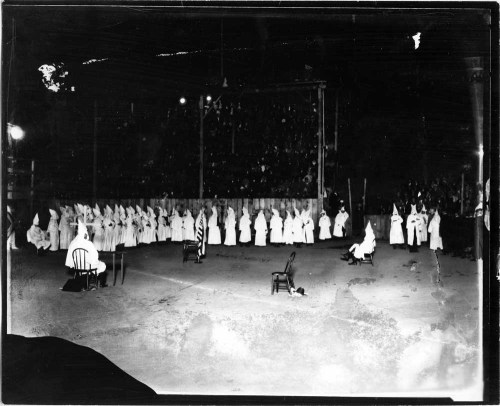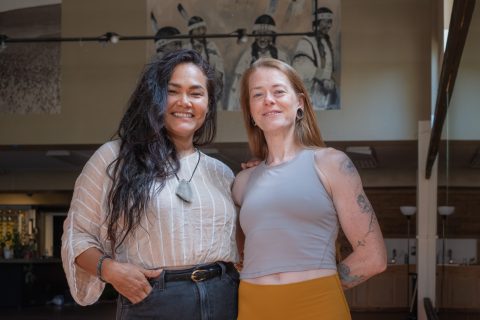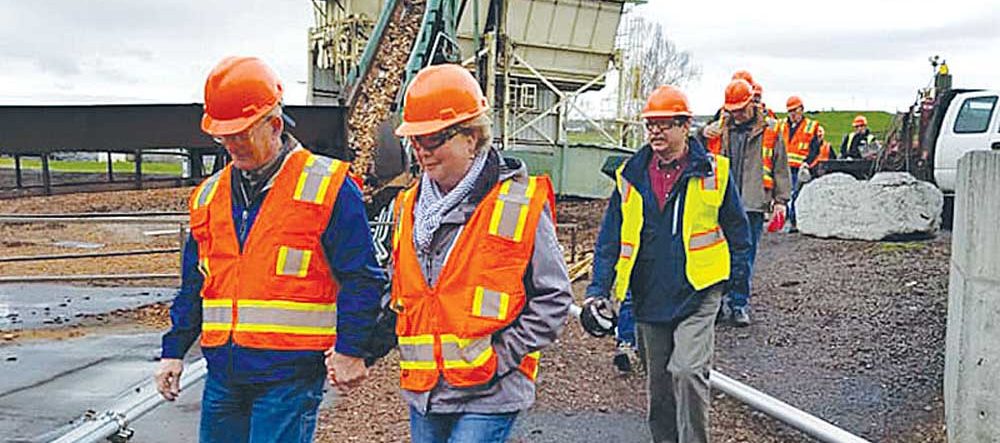Ku Klux Klan threatens Astoria paper and comes to Eastern Oregon
Published 7:00 am Saturday, September 21, 2019

- This Ku Klux Klan meeting took place in front of the stadium at Columbia Field, below J.J. Astor School. The stadium was constructed in 1922.
By the 1920s, the East Oregonian‘s owners looked for opportunities beyond Pendleton. They had the financial resources to buy two other daily newspapers — in Astoria, Oregon and Twin Falls, Idaho. Under the strong leadership of E.B. Aldrich at the EO and Merle Chessman at the Astoria Budget, those papers thrived financially; the venture with the Twin Falls Times did not turn out as well.
The next big cause promoted by the EO under Aldrich’s editorship was the Pendleton Round-Up. The show the organizers had in mind would showcase horsemanship, cowboy skills, and Native American pageantry and life ways. Participants would be actual working cowboys and Native Americans from reservations throughout the Pacific Northwest. It would have an authenticity that the typical Wild West shows of the era could not muster.
Trending
Ironically, the Round-Up organizers were portraying a way of life no longer typical of Umatilla County in 1910. Bronco-busting tournaments and Native American war dances described a time in the 1870s and 1880s when cattle and cowboys dominated the rangeland of Umatilla County and the Bannock War of 1878 caused turmoil on the Umatilla Indian Reservation. Such scenes and events gradually were replaced by wheat farming and sheep raising in northeastern Oregon. On the eve of the 1911 Round-Up, Aldrich admitted as much in an editorial when he wrote, “The show is not intended to depict the life in this country at this time, for the Round-Up is not typical of Pendleton and of eastern Oregon these days.”
In the 1920s, the Ku Klux Klan bedeviled Oregon’s political and social life. The largely homogenous population of Oregon fell prey to the racist and nativist propaganda of the KKK — which purported to be defending traditional Protestant, white patriotic values from what they considered were the un-American beliefs of immigrants, Blacks, Jews, and Catholics. As the KKK developed a sizable following throughout the state, the editors of the Daily Astorian and the East Oregonian felt compelled to challenge the KKK’s discriminatory beliefs and actions in their communities.
Both La Grande and Baker City also became hotbeds of Klan activity, with La Grande’s Klavern boasting over 300 members. On several occasions in 1923 and 1924, hundreds of white-robed and masked Klansmen paraded through downtown La Grande and Baker City and lit fiery crosses on the edge of town.
The meeting records of the La Grande Klavern, published in “Inside the Klavern” (1999), reveal the depth of the Klan’s antipathy towards Catholics, Jews, Blacks, and Asians and recount the pushback the Klan received when it attempted to enforce its beliefs on the larger community. The La Grande Klan, for example, met resistance when trying to get the school board to hire only Protestant teachers and employees and when they sought the firing of a local banker who was Catholic. Walter Pierce of La Grande was elected governor of Oregon in 1922 with Klan help.
Amidst this highly charged environment, Chessman made his position clear. While he could accept some of the candidates that had Klan support and the general patriotic values of the organization, he editorially denounced the Klan’s political agenda and its blatant falsehoods.
In response to Chessman’s editorials, the Klan sought to undermine Chessman by calling for boycotts and bans on the Budget and by demanding that Aldrich remove Chessman or sell the paper.
Trending
In response, Aldrich made it clear that he supported the editorial independence of Chessman. He wrote: “No true newspaper wants to make any promise of editorial action in advance of an event because it is impossible to foresee what may develop and to make a pledge of that sort would mean to sacrifice a paper’s independence. That would not be good journalism and it should not be expected of us. … We wish to remain free to praise or criticize as conditions may demand and we would not give up that right even for the president of the United States.”
The Klan was also active in Pendleton, as the East Oregonian reported. “Under the light shed by a fiery cross in the arena at Round-Up park a class of more than 100 candidates were initiated in to the Pendleton branch of the Ku Klux Klan last night in the first public ceremonial ever held here. The grand stand was packed with people who attended to see the ceremony. Preceding the ceremony, klansmen to the number of approximately 275 in costume, paraded from the hall on Main street to the Round-Up grounds. … Fiery crosses on both the north and south hills burned during the evening for several hours.”
In 2018, EO Media Group published an historical book by author William F. Willingham, “Grit and Ink: An Oregon Family’s Adventures in Newspapering, 1908-2018” (http://books.eomediagroup.com/grit-ink/) Since its publication, the family-owned media company that owns and operates the East Oregonian has doubled in size, having recently acquired newspapers in La Grande, Baker City, Bend and Redmond. The following story is excerpted from this book and is part four of a seven-part weekly series.









